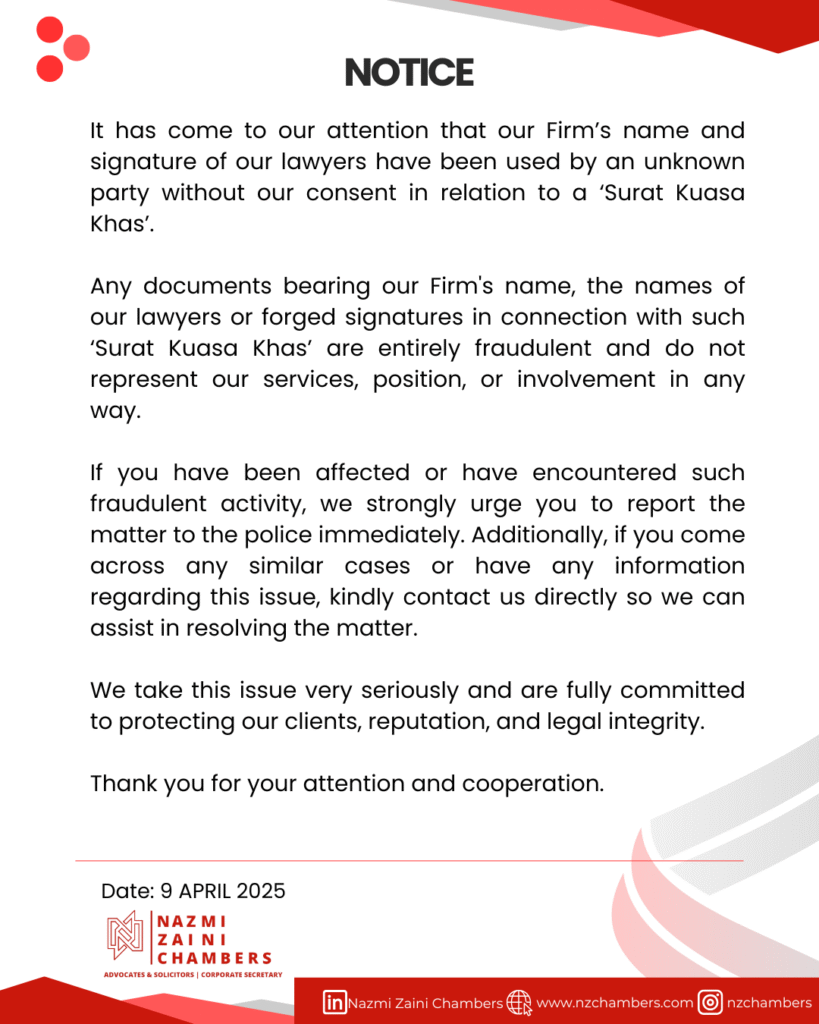Understanding Freezing and Seizure Orders under AMLATFPUAA 2001
Within the purview of Section 44 of the Anti-Money Laundering, Anti-Terrorism Financing and Proceeds of Unlawful Activities Act 2001 (AMLATFPUAA)1, the issuance of a freezing order by an enforcement agency plays a pivotal role in maintaining the integrity of an individual’s assets during an investigation of suspected money laundering or terrorism financing offenses. Such an order is judiciously applied in scenarios where there’s a substantiated belief that the individual may engage in these crimes, or if the assets in question are believed to be tied to criminal undertakings.
During the tenure of a freezing order, the asset holder is strictly barred from any form of transactions involving the assets. This encompasses the sale, transfer, disposal, collateralisation, or even relocation of assets outside the Malaysian jurisdiction, tailored to the specifics of the given order. Moreover, as a precautionary measure to deter absconding, the implicated individual might be compelled to relinquish their passport to the Director-General of Immigration. It’s incumbent upon the enforcement agency to furnish both the Public Prosecutor and, where applicable, Bank Negara Malaysia as the Competent Authority under Section 7 of AMLATFPUAA 20012 with the freezing order and a detailed inventory of the immobilised assets.
Should the implicated individual not face formal charges within a 90-day window from the order’s imposition, the order might transition to a seizure order. A notable provision under Section 44A of AMLATFPUAA 20013 allows for the amendment or annulment of a freezing order by the issuing authority under certain prerequisites, including a reassessment outcome by a senior officer or an appeal by an aggrieved party.
Conversely, under Section 45 of AMLATFPUAA 20014, seizure orders target movable assets suspected of embodying or representing proceeds of money laundering or terrorism financing occurrences. These orders are procured through an authorised officer and necessitate briefing both the Public Prosecutor and the asset owner post-seizure, barring situations where the seizure unfolds in the owner’s presence.
Interestingly, seized assets may, under specified conditions, be temporarily relinquished back to the owner either for use or sale, contingent upon the proceeds’ submission. Section 46 of AMLATFPUAA 20015 delineates this prospect, provided sufficient guarantee is offered for the asset’s return upon the agency’s request, distinguishing seizure orders from freezing orders and emphasising a 12-month application window post the freezing order.
Asset Forfeiture Dynamics under AMLATFPUAA 2001
For assets caught up under the AMLATFPUAA framework due to money laundering or terrorism financing charges, forfeiture is a conceivable outcome post-prosecution per Section 55 of AMLATFPUAA 20016 or even sans prosecution or conviction, as outlined in Section 56 of AMLATFPUAA 20017. Herein, the onus is on the Public Prosecutor, convincing the High Court of the asset’s linkage to the crimes, to initiate a forfeiture order.
In a series of legal decisions, Malaysian courts addressed the Public Prosecutor’s attempts to forfeit assets under Section 56, facing mixed outcomes. Notably, in PP v Mohd Bakri Samsu & Anor [2016] 5 CLJ 8248 and PP v Billion Nova Sdn Bhd & Ors [2015] 2 CLJ 7639, courts denied forfeiture requests due to insufficient evidence of money laundering or clear linkage of assets to unlawful activities. Specifically, in the Billion Nova case, the Court of Appeal found the evidence inadequate to establish that funds in the respondents’ accounts, allegedly from selling duty-free cigarettes illegally, were indeed proceeds of a crime. Conversely, in Azmi bin Osman v PP [2016] 3 MLJ 9810, the High Court and Court of Appeal ruled in favour of forfeiture, convinced that the funds in question were linked to illegal gambling and corruption, thereby meeting the proof requirements under Section 56 of AMLATFPUAA 200111. These cases highlight the challenges in proving the illegal origin of assets for forfeiture under Malaysian law. In instances where the asset is no longer accessible, possibly due to prior disposition by the defendant, the court is empowered to enforce a financial penalty equivalent to the asset’s value, mirroring the evidentiary threshold of civil proceedings.
Addressing Third-Party Property Implication in Crimes
For individuals who find their property inadvertently caught in criminal proceedings, AMLATFPUAA 2001 provisions pave a route to contest such encroachments, advocating for third-party rights via a public notice in the Gazette for claim substantiation.
Section 61 of AMLATFPUAA 200112 delineates criteria under which the court may redress the seized property to the rightful owner, conditional upon proven legal interest, non-complicity, unawareness of the property’s misuse, acquisition devoid of forfeiture evasion indication, and demonstrable preventive measures against unlawful utilisation. Meeting these criteria demands a rigorous evidential standard, with legal counsel instrumental in navigating this complex landscape.
The Court of Appeal’s ruling in Lim Hui Jin v CIMB Bank Bhd & Ors [2018] 6 MLJ 72413 clarified the limits and scope of freezing and seizure orders under the AMLATFPUAA 2001. In this case, the appellant’s bank account was initially frozen and then seized due to his mother’s investigation for money laundering. However, since no charges were filed against the appellant within the required 90 days for the freezing order and 12 months for the seizure order, the Court ordered the release of his account. The decision highlighted that seizure orders cannot be maintained indefinitely without formal charges and that forfeiture under Sections 5514 and 5615 of AMLATFPUAA 2001 applies only to the individual from whom the property was seized. This ruling reinforces the constitutional right to property, ensuring that enforcement agencies must complete their investigations and prosecute within the specified timeframes to prevent the indefinite holding of assets.
Similarly in the case of Public Prosecutor v Habib Jewels Sdn Bhd [2020] 12 MLJ 757, the High Court dealt with an application for forfeiture of funds linked to alleged corruption, specifically under Section 23 of the MACC Act16, involving the former Prime Minister Dato’ Seri Najib Razak. The court was tasked to determine if the funds in question, received by Habib Jewels from Najib Razak for jewellery purchases, were indeed proceeds from unlawful activities. The court concluded that the prosecution failed to establish a direct link between the alleged offences and the funds, highlighting the necessity of proving the origin of such funds as unlawful. Additionally, the court recognised that Habib Jewels received the funds in good faith, through legitimate business transactions, before any allegations against Najib were public. Consequently, the application for forfeiture was dismissed, underscoring the principle that legal ownership of property must be respected unless there’s conclusive evidence to the contrary, in line with Section 56 of AMLATFPUAA 2001 and Article 13 of the Federal Constitution, which safeguards against the deprivation of property without legal justification. This case highlights the complex interplay between criminal allegations and the sanctity of lawful business transactions, setting a precedent on the scrutiny required for forfeiture orders within the financial and legal framework.
Advisory for Affected Asset Holders under AMLATFPUAA
For those not yet charged by the Deputy Public Prosecutor, seeking recourse through legal avenues for the release of frozen assets is advisable. Expertise in this domain is crucial, underscoring the value of engaging a legal professional well-versed in AMLATFPUAA intricacies to bolster the likelihood of asset recovery.
If you have any questions or queries, please contact our Advisory & Compliance Partner, Mr. Afif Che Had (afif@nzchambers.com).
Author: Afif Che Had
References:
[1] Section 44 of AMLATFPUAA 2001.
[2] Section 7 of AMLATFPUAA 2001.
[3] Section 44A of AMLATFPUAA 2001
[4] Section 45 of AMLATFPUAA 2001
[5] Section 46 of AMLATFPUAA 2001
[6] Section 55 of AMLATFPUAA 2001
[7] Section 56 of AMLATFPUAA 2001
[8] PP v Mohd Bakri Samsu & Anor [2016] 5 CLJ 824
[9] PP v Billion Nova Sdn Bhd & Ors [2015] 2 CLJ 763
[10] Azmi bin Osman v PP [2016] 3 MLJ 98
[11] Section 56 of AMLATFPUAA 2001
[12] Section 61 of AMLATFPUAA 2001
[13] Lim Hui Jin v CIMB Bank Bhd & Ors [2018] 6 MLJ 724
[14] Section 55 of AMLATFPUAA 2001
[15] Section 56 of AMLATFPUAA 2001
[16] Section 23 of the MACC Act





